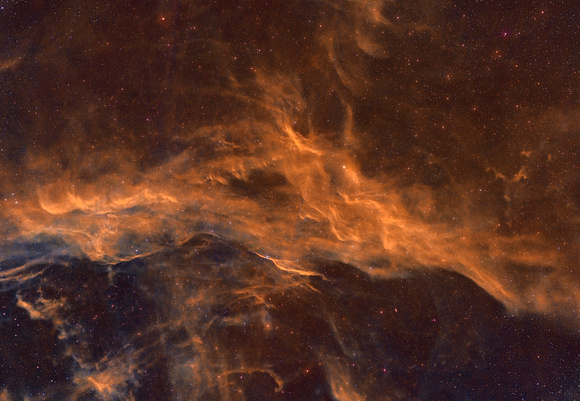An Egg Hunt – The A-frame Emission Nebula around the Egg Nebula in SHO Televue 127is; AP Mach2 GTO
ASI6200MM, - Baader RGB & 6.5nm NB CMOS opt. filters
H,S,O – (26,15,16 x 600s, Bin 1, Gain 100)
R,G,B – (12,9,9 x 180s Bin 1, Gain 100)
Total integration time = 11 hrs
My interest in protoplanetary nebulae sparked a potential interest in using a large aperture telescope to image the Egg Nebula in Cygnus. While going through the sky atlas in Nina to find it, I came across an interesting large emission nebula (including LBN 146, 166, 269, and 250) instead and decided to shoot that with my wider field refractor.
I couldn’t find a common name for this one, so I dubbed it the A-frame as it is composed of three “linear like” features in that shape. It interested me because it is quite filamentary in parts – much like the more popular Sh2-113/114 Flying Dragons in Cygnus. These filamentary parts almost look like they should be part of an SNR. The other odd thing, is just like the Flying Dragons, the signal is much stronger in Ha (very strong) and S, than O. While there is obviously some ionizing UV in the area to energize the emissions, I imagine it isn’t strong enough to ionize much oxygen (or the oxygen is either too dense for the forbidden emission line, or absent). To be honest though, this subject does deserve additional integration time.
When processing the subs, I wanted to see if I could “find” the original target that led me here – The Egg Nebula. The Hubble image of this cool object is
here, but of course it is much smaller in this image. The multicoloured egg shells can’t be seen, but the two lobes (similar to the lobes of Minkowski’s Footprint – another small protoplanetary) and the central star blocking dust can be made out. If you have trouble finding it you can mouseover/move to to the starless image (it is supposed to be an egg hunt after all). In these images, the Egg appears in NB, but the RGB version is also interesting. At least I can say I captured it with my 5 inch refractor!


